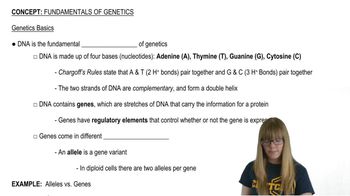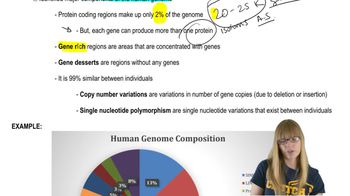How are the carbon and nitrogen atoms of the sugars, purines, and pyrimidines numbered?
Table of contents
- 1. Introduction to Genetics51m
- 2. Mendel's Laws of Inheritance3h 37m
- 3. Extensions to Mendelian Inheritance2h 41m
- 4. Genetic Mapping and Linkage2h 28m
- 5. Genetics of Bacteria and Viruses1h 21m
- 6. Chromosomal Variation1h 48m
- 7. DNA and Chromosome Structure56m
- 8. DNA Replication1h 10m
- 9. Mitosis and Meiosis1h 34m
- 10. Transcription1h 0m
- 11. Translation58m
- 12. Gene Regulation in Prokaryotes1h 19m
- 13. Gene Regulation in Eukaryotes44m
- 14. Genetic Control of Development44m
- 15. Genomes and Genomics1h 50m
- 16. Transposable Elements47m
- 17. Mutation, Repair, and Recombination1h 6m
- 18. Molecular Genetic Tools19m
- 19. Cancer Genetics29m
- 20. Quantitative Genetics1h 26m
- 21. Population Genetics50m
- 22. Evolutionary Genetics29m
7. DNA and Chromosome Structure
DNA Structure
Problem 16e
Textbook Question
Which of the following equations are true for the percentages of nucleotides in double-stranded DNA?
(A)/(G)=(T)(C)
 Verified step by step guidance
Verified step by step guidance1
Understand the context: In double-stranded DNA, the base pairing rules (Chargaff's rules) state that adenine (A) pairs with thymine (T) and guanine (G) pairs with cytosine (C). This means the amount of A equals T, and the amount of G equals C.
Analyze the given equation: The equation provided is (A)/(G) = (T)(C). This equation suggests a relationship between the percentages of the nucleotides in double-stranded DNA.
Check the left-hand side of the equation: The term (A)/(G) represents the ratio of adenine to guanine. According to Chargaff's rules, there is no direct proportionality between A and G, as A pairs with T and G pairs with C.
Check the right-hand side of the equation: The term (T)(C) represents the product of the percentages of thymine and cytosine. Again, there is no direct relationship between T and C in terms of multiplication, as T pairs with A and C pairs with G.
Conclude the validity of the equation: Based on Chargaff's rules, the equation (A)/(G) = (T)(C) does not hold true for double-stranded DNA. The relationships between nucleotide percentages are A = T and G = C, not the given equation.
 Verified video answer for a similar problem:
Verified video answer for a similar problem:This video solution was recommended by our tutors as helpful for the problem above
Video duration:
4mPlay a video:
Was this helpful?
Key Concepts
Here are the essential concepts you must grasp in order to answer the question correctly.
Chargaff's Rules
Chargaff's Rules state that in double-stranded DNA, the amount of adenine (A) equals thymine (T), and the amount of guanine (G) equals cytosine (C). This means that A pairs with T and G pairs with C, leading to a specific ratio of these nucleotides in the DNA structure. Understanding these rules is essential for analyzing nucleotide percentages.
Recommended video:
Guided course

Genetics Basics
Base Pairing
Base pairing refers to the specific hydrogen bonding between nucleotides in DNA, where adenine pairs with thymine and guanine pairs with cytosine. This complementary pairing is crucial for the stability of the DNA double helix and ensures accurate replication and transcription. Recognizing base pairing is vital for interpreting nucleotide ratios.
Recommended video:
Guided course

Base Distortions
Nucleotide Composition
Nucleotide composition in DNA refers to the relative amounts of the four nucleotides: adenine, thymine, guanine, and cytosine. In double-stranded DNA, the total percentage of A and T should equal that of G and C due to base pairing. This composition is fundamental for understanding the equations related to nucleotide percentages.
Recommended video:
Guided course

Human Genome Composition
Related Videos
Related Practice
Textbook Question
623
views


